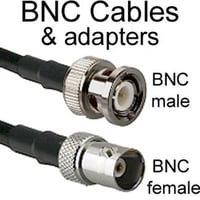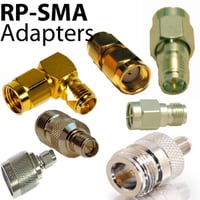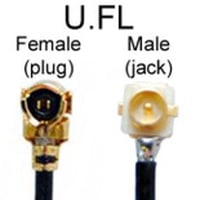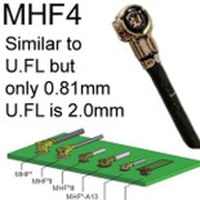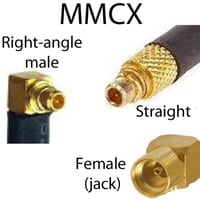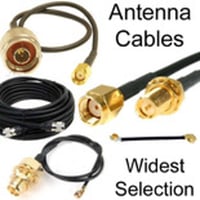Adapters with BNC connector(s)
BNC Cable Joiners, Couplers, Gender Changers for CCTV Video and Audio
A Quick-Connect / Quick-Release Connector
- BNC is a locking, round connector with slotted mating collar.
- Quick-connect / quick release connector for coaxial cable: BNC connectors connect with a half-turn.
- These connectors twist and lock onto the jack, with a half-turn, unlike SMA, N, and RP-TNC, that have threaded connections.
- BNC is used in situations where quick disconnect capabilities are required or convenient.
- The ability to effortlessly disconnect and connect securely enables devices to have easily removable / retractable antennas or BNC extension cables for rapid swapping.
Gender is determined by the inside wire - not the outside connector.
BNC is not only used for antenna cables, but also for CCTV and other video applications, audio, TV receivers, and networking coax applications.
BNC RF connector is used for terminating a variety of miniature to standard RG coax cables. Terminating a coax cable to the connector can be done either by clamping or crimping.
The Bayonet Neil-Concelman, also known as BNC connector is a specialized connector used with co-axial cable and designed to work at multi-megahertz radio frequencies. This miniature connector maintains the co-axial cable shielding and provides a low impedance connection that can be rapidly assembled and dismantled.
BNC Connector Structure and Function
The BNC connector comprises:
- A male part which typically is attached to a coax cable.
- A female connector usually anchored to the relevant piece of equipment.
BNC connectors mate using a bayonet connection:
- Radial pins on the male interlock with
- L-shaped slots on the female connector with a quarter turn. This is a secure connection which is not easily dislodged or accidentally pulled out.
Within the connector there is:
- A center pin or contact
- An inner contact area
- An outer contact layer
- And a die-cast BNC connector body/housing
The terminus of the connector can be either crimped or soldered.
- Crimp type BNC connectorscan be accurately matched and attached to a trimmed and stripped coax cable with an appropriate crimping tool. They comprise a crimp outer sleeve known as a ferrule as well as a centre pin that can also be crimped.
- Solder type BNC connectors Are more difficult to install but are an alternative where the more common crimp type connectors are unavailable. These connectors are again attached to trimmed and stripped cable. They possess a solder center pin and connect the braid of the coax cable to an inner ferrule with a stuffing-nut attachment.
These connectors have been made to match the impedance of the BNC cable to which they are attached and are typically available with 50 ohm or 75ohm impedance typical. BNC connectors usually work with frequencies of 4GHz or less with the 75 ohm connector specified for frequencies of around 2 GHz.
BNC cable and connector applications
Originally developed for military use, BNC cables and connectors were initially adapted for use in early computer networks particularly those using Ethernet. The uses of BNC cables have since expanded to include a wide variety of Radio Frequency (RF) applications including:
- Aerospace: BNC connectors create a stable and robust connection that can endure the environmental pressures, temperature and pressure changes and vibrations experienced in aviation.
- Test equipment: BNC cables and connectors offer ease of use and a secure connection in test equipment such as audio generators, power meters and oscilloscopes.
- Television: The 50 and 75 ohm impedances of BNC connectors enable them to efficiently carry signal rather than power over distances making them a favorable choice in the television industry. New ranges of custom and modified BNC HD connectors are now finding use for HDTV applications also.
- Video: BNC has an ideal impedance for video and the coax cable provides well shielded transmission.
- Radio: BNC Antennaswith a BNC antenna extension have a wide variety of Radio Frequency applications making them useful in Ham radio connections. A BNC antenna can be connected to a BNC antenna extensioncable for a variety of radio applications working across AM, FM, HF, UHF and VHF frequencies. A number of omni-directional antennas can be acquired that will work with the BNC connector.
- Audio The secure bayonet connection of BNC connections and cables work for digital audio input and output where they are thought to increase signal accuracy.
BNC Connector Combinations and Variants
Given the wide range of applications for the BNC connector it is no surprise that there are broad range of BNC connector and cable combinations, BNC connector adapter and BNC cable adapter products to provide exact solutions for the varied set-ups for which BNC connectors are required. BNC adapters are useful in most applications where they provide a greater range of mating combinations. Adapter types include:
- The "straight through adapter’ which permits a BNC male to BNC male cable connection
- Adapters which have two female connectors at either horizontal end and a male connector at the bottom which can facilitate multiple male to female BNC cables being connected at a single point.
- Interseries adapters facilitate connections between different types of connector.
- BNC Mini or mini BNC connectors are around 40% smaller than the original BNC connector and offer the utility and security of a BNC where space is limited or much smaller diameter BNC extension cable is used. Mini BNC to BNC cable is used for frequencies up to 2GHz. Mini BNC to BNC adapter set-ups further extend the versatility of this established and reliable connector.
History
BNC stands for Bayonet Neill-Concelman connector. Bayonet represents the physical connector kind and Neill and Concelman are the inventors of the BNC connector (invented in the late 1940s).

